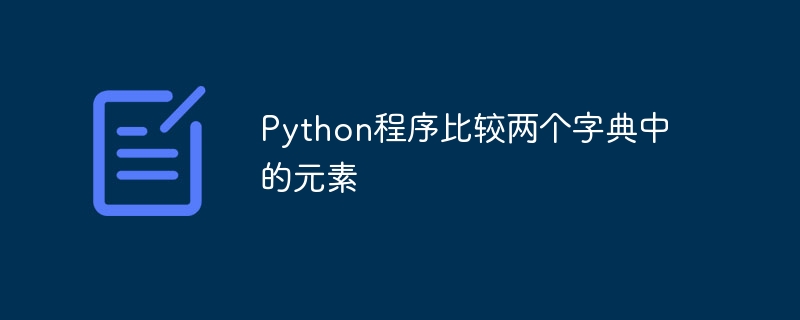
Dictionaries are a powerful data type in Python that allow you to store data as key-value pairs. In this article, we will be discussing how to compare elements in two dictionaries in Python. We will go over the syntax for comparing dictionary elements and will provide examples of how to do so.
在Python中,可以透過將一系列元素放置在花括號 { } 中,用逗號(,)分隔來建立字典。字典保存鍵值對,其中一個是鍵,另一個是對應的值。
Values in a dictionary can be of any data type and can be duplicated, whereas keys can't be repeated and must be immutable and unique. The name of keys in a dictionary is case sensitive and unique. The name of keys in a dictionary is case sensitive and unique. The name of keys in a dictionary is case sensitive and unique. The name of keys in a dictionary is case sensitive。 built-in function dict(). An empty dictionary can be created by just placing to curly brackets { }.
We can declare a dictionary in the following way −
thisdict = { "brand": "Ford", "model": "Mustang", year": 1964 }
在這篇文章中,我們將會看到如何使用3種不同的方法在Python中比較兩個字典的元素。
在這種方法中,我們將使用雙等號比較運算子來比較兩個字串。當操作符的左右兩邊相等時,== 運算子傳回 true,當它們不相等時傳回 false。
If the 2 dictionaries given to us are equal and identical to each other, this operator will return true and we can conclude that the two dictionaries are equal. And it will return false if they are not equal.
#Example
dict1 = { 'first' : 'apple' , 'second' : 'orange' , 'third' : 'mango' }
dict2 = { 'first' : 'apple' , 'second' : 'orange' , 'third' : 'grapes'}
if dict1 == dict2:
print (" dict1 is equal to dict2 ")
else:
print (" dict1 is not equal to dict2 ")
dict1 is not equal to dict2
我們也會檢查兩個字典的長度,如果它們不相同,我們可以直接得出結論,這兩個字典不相等。要取得字典中與鍵對應的值,我們使用. get函數,該函數給出作為參數的鍵的值。
Example
dict1 = { 'first' : 'apple' , 'second' : 'orange' , 'third' : 'mango' }
dict2 = { 'first' : 'banana' , 'second' : 'guava' , 'third' : 'grapes'}
if len (dict1) != len (dict2):
print ("The dictionaries are not equal ")
else:
flag=0
for i in dict1:
if dict1.get(i) != dict2.get(i):
flag=1
break
if flag==0:
print (" dict1 is equal to dict2 ")
else:
print (" dict1 is not equal to dict2 ")
dict1 is not equal to dict2
Example
dict1 = { 'first' : 'apple' , 'second' : 'orange' , 'third' : 'mango' }
dict2 = { 'first' : 'banana' , 'second' : 'guava' , 'third' : 'grapes' }
ans = all ( dict2.get (key) == value for key , value in dict1.items() )
if ans == 'true':
print ("dict1 and dict2 are equal")
else:
print ("dict1 and dict2 are not equal")
dict1 and dict2 are not equal
The first method involved use of equality operator ( ==). The second method involved use of iteration to check each and every key value pair of both the dictionaries. In the final method we used the list pair of both the dictionaries. In the final method we used the list compresion inpyed the list over key value pair of one dictionary and check the values for the keys in both dictionaries and compared them.
The time complexity of 1
stapproach is O (1) as it uses simple comparison. Whereas the other 2 method have time complexity of O (n). where n is the length of diction have time complexity of O (n). where n is the length of dictionary.
以上是Python程式比較兩個字典中的元素的詳細內容。更多資訊請關注PHP中文網其他相關文章!




